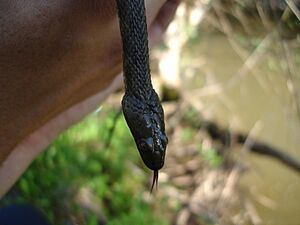Dice snake facts for kids
Quick facts for kids Dice snake |
|
|---|---|
 |
|
| Scientific classification | |
| Kingdom: | |
| Phylum: | |
| Class: | |
| Order: | |
| Suborder: | |
| Family: | |
| Genus: | |
| Species: |
N. tessellata
|
| Binomial name | |
| Natrix tessellata (Laurenti, 1768)
|
|
The Dice snake (scientific name: Natrix tessellata) is a type of snake found in Europe and Asia. It's part of the Colubridae family, which includes many common snakes. This snake is not venomous, meaning it doesn't have poison.
Dice snakes are often found near water, like rivers and lakes. They have a slender body, which helps them move easily in water. You might spot them in woodlands, deserts, or even mountain streams. They mostly eat fish, but sometimes they also snack on amphibians like frogs.
These snakes can grow up to 90 cm long. They usually have a brown or grey color. Dice snakes are a bit shy. When they feel threatened, they have a few clever ways to protect themselves. They can release a very bad-smelling liquid. Another trick they use is playing dead, which is called thanatosis.
Dice snakes hibernate, or sleep, during the colder months. They find dry holes near water and stay there from October to April.
Where Dice Snakes Live
Dice snakes live in many countries across Europe and Asia. You can find them in places like:
- Germany
- Switzerland
- Austria
- France
- Italy
- Poland
- Hungary
- Turkey
- Greece
- Russia
- Ukraine
- China
- Pakistan
- And many other countries in the Middle East and Central Asia.
What Dice Snakes Do
Dice snakes love living near water, such as river streams or lakes. This is because their favorite food, fish, lives there! They are very good at catching fish. Sometimes, they also eat amphibians like frogs, toads, and even tadpoles.
As mentioned, these snakes are not venomous. They have special ways to defend themselves:
- They can release a very bad-smelling liquid from their body. This smell helps scare away predators.
- They can also pretend to be dead. This trick, called thanatosis, makes predators think the snake isn't worth eating.
During the mating season, which is usually in spring (March to May), many Dice snakes gather together. Female snakes lay their eggs in July. A female can lay between 10 and 30 eggs at one time. The baby snakes hatch from their eggs in early September.
Images for kids
-
An old illustration showing a Dice snake (top) and a grass snake (bottom).






